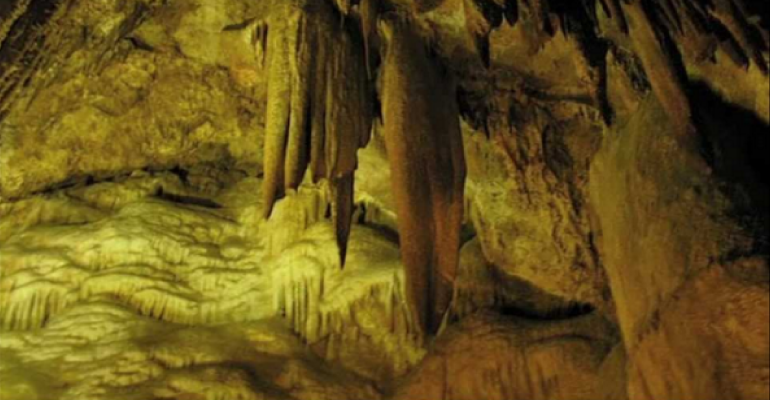
There are many kinds of caves. Most of us are familiar with solution caves in limestone such as Colossal Cave in Tucson, or Kartchner Cave near Benson. There are also caves in volcanic rock such as lava tubes near Flagstaff. Caves can be formed in any type of rock by the action of the sea and by tectonic activity. And there are caves in ice.
How many caves are there in Arizona? By one count, more than 1,600.
Limestone solution caves:
Limestone caves have a geologically short lifetime, usually less than a few million years, and more often, just a few thousand years.
Most limestone in Arizona was deposited when the area was beneath the sea during the Paleozoic era 500 million to 250 million years ago. Both Colossal Cave and Kartchner Caverns occur within the approximately 330-million-year-old Escabrosa Limestone.
Limestone solution caves form just below the water table. Groundwater, made slightly acidic by dissolved carbon dioxide, passes through cracks and pores, and dissolves some of the limestone. In some areas, such as at Colossal Cave, weak sulfuric acid from volcanic exhalations also helped dissolve the limestone. Over time the cavities become larger and, if the water table is lowered due to erosion outside the cave, multilevel passages are formed.
Cave decorations such as stalagmites and stalactites don’t form until the cave is exposed to the air, perhaps by a stream intersecting one of the passages. Once that happens, cave formation ceases. It’s just like opening a can of soda pop; the carbon dioxide dissipates leaving the water less acidic. There are two discrete processes which can cause precipitation of calcium carbonate:
1) Evaporation of water increases the concentration of calcium until the solubility of calcium is exceeded and,
2) Out-gassing of carbon dioxide causes slow precipitation of calcium carbonate.
The final stage in the life of a limestone cave is collapse. As the water table lowers and surface erosion continues, the caves dry out and the ceiling of caves collapse, producing sink holes. The end stage is a land-form called Karst topography characterized by subterranean drainage which leaves a barren surface, and after more erosion, can leave limestone spires.
Lava tubes:
Lava tube caves occur in the San Francisco volcanic field near Flagstaff. These were formed about 700,000 years ago within lava flows when a crust was formed around a flow channel and the still hot fluid lava flowed out of the cylindrical crust. Lava tube caves can contain formations similar to limestone caves if conditions are right. The longest known lava tube cave is Kazumura Cave in the eastern slope of Kilauea on Hawaii. It is 3,614 feet long.
Speleothems:
Formations of calcium carbonate and gypsum (calcium sulphate) within caves are called speleothems. You can see a list, explanation of formation, and photos here. Most familiar are stalagmites (“g” forming on the ground), stalactites (“c” forming on the ceiling), and flowstone which forms curtains and other formations such as “cave bacon” which was the subject of a recent “tongue-in-cheek” ADI article.
Some cave statistics:
The cave system with the greatest total length of surveyed passage is Mammoth Cave, Kentucky, with 367 miles of passages.
The longest surveyed underwater cave is the Ox Bel Ha Cave System in Yucatán, Mexico with 110 miles of passages.
The deepest known cave (measured from its highest entrance to its lowest point) is Voronya Cave (Abkhazia, Georgia), which is 7,190 feet deep.
The deepest vertical shaft in a cave is 1,980 feet in the Vrtoglavica Cave in Slovenia.
The largest room ever discovered is the Sarawak chamber, in the Gunung Mulu National Park (Miri, Sarawak, Borneo, Malaysia), a sloping, boulder strewn chamber with an area of approximately 2,300 feet by 1,300 feet and 260 feet high.
For a story on how caves contribute to our knowledge of sea level fluctuations, see:
http://tinyurl.com/yh4eydhAncient Sea-levels Rewrite Ice Age Transitions
For a detailed explanation of how speleothems form and how they may be used to reconstruct paleoclimate, see this paper: Carbonate Stable Isotopes/speleothems. This paper contains some nice photos also.
Related:
A Brief Geologic History of Arizona Chapter 1 Precambrian
A Brief Geologic History of Arizona Chapter 2 Cambrian and Ordovician time
A Brief Geologic History of Arizona Chapter 3 Silurian to Permian
Arizona Geological History Chapter 4: Triassic Period
A brief geologic history of Arizona Chapter 5: Jurassic Time
A brief geologic history of Arizona Chapter 6: Cretaceous Time
A brief geologic history of Arizona Chapter 7, the Cenozoic Era
Note to readers: I have constructed a linked index to more than 300 of my ADI articles. You can see it at: https://wryheat.wordpress.com/adi-index/
You can read my comprehensive, 28-page essay on climate change here: http://wp.me/P3SUNp-1bq
